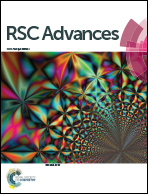Rice husk biochar modified-CuCo2O4 as an efficient peroxymonosulfate activator for non-radical degradation of organic pollutants from aqueous environment†
Abstract
A series of rice husk biochar (RHBC) modified bimetallic oxides were prepared using a simple pyrolysis method to activate peroxymonosulfate (PMS) for the degradation of acid orange G (OG). The results demonstrated that 50 mg L−1 OG was completely decomposed by 1 mM PMS activated with 100 mg L−1 RHBC–CuCo2O4 within 15 min at initial pH 3.4. The OG degradation rate constant k of RHBC–CuCo2O4/PMS (0.95 × 10−1 min−1) was five times greater than that of CuCo2O4/PMS (0.19 × 10−1 min−1), suggesting that the introduction of RHBC significantly improved the activity of bimetallic oxides. The effects of the initial pH, catalyst dosage, PMS concentration and reaction temperature on OG removal were also studied. The degradation products of OG were analysed using a gas chromatography-mass spectrometer (GC-MS). Electron paramagnetic resonance (EPR) and quenching experiments showed that singlet oxygen (1O2) was the main active species. The RHBC–CuCo2O4/PMS oxidation system is not only unaffected by inorganic anions (Cl−, NO3−, HCO3−) and humic acid (HA), but also could remove other typical pollutants of acetaminophen (ACT), sulfathiazole (STZ), rhodamine B (RhB), and bisphenol A (BPA). These findings show that RHBC–CuCo2O4 has great potential for practical applications in the removal of typical organic pollutants.



 Please wait while we load your content...
Please wait while we load your content...